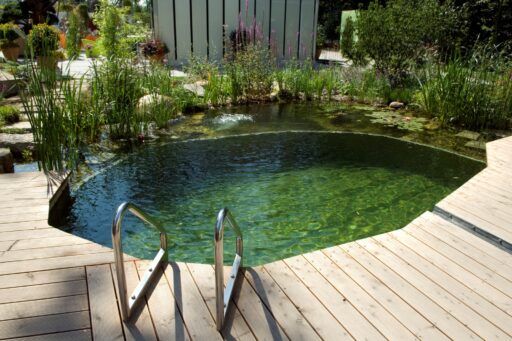While a traditional pool delivers that familiar swimming vibe with its clear and chemically treated water, a natural swimming pond serves as a tranquil, environmentally friendly refuge. The distinction lies not only in aesthetics but also in achieving the right equilibrium between nature and functionality.
This article will outline the primary differences to assist you in determining which alternative aligns best with your garden and way of life.
Grasping the Essentials
Understanding the unique features of natural swimming ponds versus conventional pools is vital when making your choice.
What Exactly Are Natural Swimming Ponds?

Natural swimming ponds operate without chemical additives like chlorine, relying instead on plants and microscopic organisms to maintain clean water. These ponds are crafted to form a harmonious ecosystem, where vegetation absorbs nutrients and inhibits algae growth, ensuring the water remains clear and healthy.
Typically, a natural swimming pond comprises two essential parts: an area designated for swimming and another known as the regeneration zone, where vegetation thrives and performs the majority of water purification. Aside from providing a refreshing, chemical-free swimming experience, these ponds add an aesthetic element to your garden, harmonizing beautifully with the surrounding environment.
If an eco-conscious alternative to a traditional pool is what you seek, a natural swimming pond could very well meet your needs. It offers a delightful swimming area along with a distinctive ornamental feature in your outdoor setting.
What Constitutes Traditional Pools?

Traditional pools are the most prevalent swimming pool type, utilizing chemicals, primarily chlorine, to maintain cleanliness and safety for users.
Generally, their design is straightforward, focusing on creating a space for swimming and relaxation. However, they require consistent maintenance, including the addition of chemicals and routine cleaning, to keep the water inviting and clear.
If you appreciate a classic and orderly appearance with straight lines and sparkling water, a traditional pool might be the ideal choice. Just be mindful of the continual upkeep and chemical treatment that it entails.
Design and Visual Appeal
Your decision between natural swimming ponds and traditional pools largely hinges on your garden’s layout and the kind of aesthetic you desire. Natural ponds integrate seamlessly into the landscape, whereas conventional pools provide traditional styles.
Swimming Ponds
When you design a natural swimming pond, including aquatic plants is essential. These plants serve significant purposes beyond mere decoration—they are vital for ensuring the water remains clean and transparent.
Typically, natural ponds exhibit irregular contours, designed to imitate the appearance of natural bodies of water like lakes and ponds. They would usually incorporate various depths. The shallower sections are ideal for planting, enabling a smooth transition to the deeper swimming zones.
Incorporating boulders and native vegetation can allow your pond to harmonize effortlessly with the surrounding environment. This thoughtful design generates a tranquil, natural vibe, transforming your garden into a peaceful retreat.
Traditional Pools
Traditional pools are characterized by their sleek, straight edges and well-defined silhouettes. Common configurations include rectangular, oval, or kidney shapes. This structured design lends itself well to both modern and classic garden aesthetics.
To elevate the look of a traditional pool, you might consider features like tiled borders or stylish decking. Lighting can be added to highlight the pool at night, giving it an exquisite feel. Elements such as infinity edges or premium materials can enhance your pool’s visual allure, making it a standout feature in your garden.
Ecology and Biodiversity

Natural swimming ponds provide a unique chance to blend your pool with the local ecosystem. They not only change your garden into a wildlife sanctuary but also foster a thriving life system.
Encouraging a Balanced Ecosystem
Creating and sustaining a balanced ecosystem in a natural swimming pond is crucial. These aquatic systems depend on helpful bacteria and water plants to purify the water naturally, supplying an eco-friendly solution.
- Beneficial Bacteria: These microorganisms decompose organic matter, helping to clear waste and maintain water clarity without resorting to chemicals.
- Aquatic Plants: These flora are instrumental in nutrient absorption, curbing algae proliferation while providing habitats for various small creatures.
Your garden can become a habitat for diverse wildlife, including frogs, insects, and birds, all of which contribute significantly to the pond’s ecosystem. These beings also assist in controlling pests naturally, decreasing the need for external intervention.
Fostering Biodiversity in Your Garden
Contrary to traditional pools, natural swimming ponds promote an increase in biodiversity within your garden.
- Various creatures, including birds and dragonflies, are frequently drawn to the water and the new habitats it offers.
- Regeneration Zones: These segments filled with aquatic vegetation not only purify the water but also provide nourishment and shelter to different species.
- The variety of plants ensures suitable living conditions for different animals, supporting a vibrant, balanced ecosystem.
Incorporating a natural swimming pond encourages a harmonious coexistence between people and nature, enriching both your garden and the surrounding environment.
Health and Wellness Advantages
Your choice between a natural swimming pond and a traditional pool can play a significant role in influencing your health and wellness. Natural ponds present a swimming experience free from chemicals, minimizing exposure to substances like chlorine.
Benefits of Swimming Without Chemicals
Natural swimming ponds offer a refreshing departure from conventional pools by removing the need for chemical additives.
- No Chemical Irritants: Many individuals suffer from skin or eye irritation caused by chlorinated water. A natural pond eliminates these problems, making swimming an enjoyable experience—particularly for those with sensitive skin.
- Healthier Water: Water quality is upheld through natural means using aquatic plants and biological filters, fostering a cleaner and healthier swimming environment.
- Accommodating for Sensitive Health Conditions: If you have respiratory issues or other health concerns, a natural pond can provide a safer and more comfortable swimming alternative.
By choosing to avoid artificial chemicals, you not only benefit personally, but you also enhance the wellbeing of the local ecosystem, transforming your garden into a healthier and more sustainable space.
Boosting Wellness Through Natural Surroundings
Natural swimming ponds are mimicked after the serene quality of natural water bodies, which can help alleviate stress. Being in a natural environment may evoke a sense of tranquility, aiding in relaxation while enhancing mental wellbeing.
Swimming regularly constitutes an excellent form of exercise. In a natural setting, you may find the experience more enjoyable, prompting frequent use. Exercising in a natural pool context not only promotes physical fitness but can also bolster psychological health.
The soothing sounds of water, the presence of greenery, and the overall beauty of the surroundings offer a more rejuvenating experience than a standard pool environment.
Maintenance and Care

Both natural swimming ponds and traditional pools entail distinct maintenance methodologies that affect the time, effort, and finances required to keep the water clean and functional.
Continuous Care for Natural Swimming Ponds
- Regeneration Zone: The vegetation here serves as a natural filter. It’s essential to regularly oversee and manage plant growth to maintain water clarity.
- Debris Clearance: Regularly removing leaves and branches prevents disruptions in the ecosystem.
- Monitoring Nutrient Levels: Keeping an eye on the nutrient content of the water ensures a thriving environment.
- Top-Up Water: You may need to replenish water during hotter months due to evaporation.
Natural ponds generally incur lower chemical costs but may call for more active ecological maintenance compared to conventional pools.
Regular Upkeep for Traditional Pools
Traditional pools depend on mechanical filtration systems and chemicals to ensure water hygiene.
- Balancing Chemicals: It’s crucial to check chlorine and pH levels frequently to keep the water safe for swimmers.
- Filtration Maintenance: Filters and pumps should be cleaned regularly to maintain operational efficiency.
- Surface Skimming: Regularly skimming the pool surface decreases strain on the filtration system.
- Routine Inspections: Regular checks for leaks or wear and tear on equipment can stave off costly repairs.
While traditional pools involve continuous chemical expenses, they usually demand less hands-on maintenance than natural ponds while potentially incurring higher electricity costs due to the equipment needed.
Concluding Thoughts
Ultimately, the choice between a natural swimming pond and a conventional pool is influenced by your personal garden aspirations.
If the concept of a chemical-free and eco-friendly oasis with an inviting habitat for wildlife appeals to you, a natural swimming pond could be your ideal selection. Conversely, if you prefer a straightforward swimming option that offers easy maintenance and a traditional appearance, a conventional pool may be a better fit for your preferences.
Both options can transform your outdoor area into a lovely relaxation spot; it’s about discovering what best caters to your taste and lifestyle.





